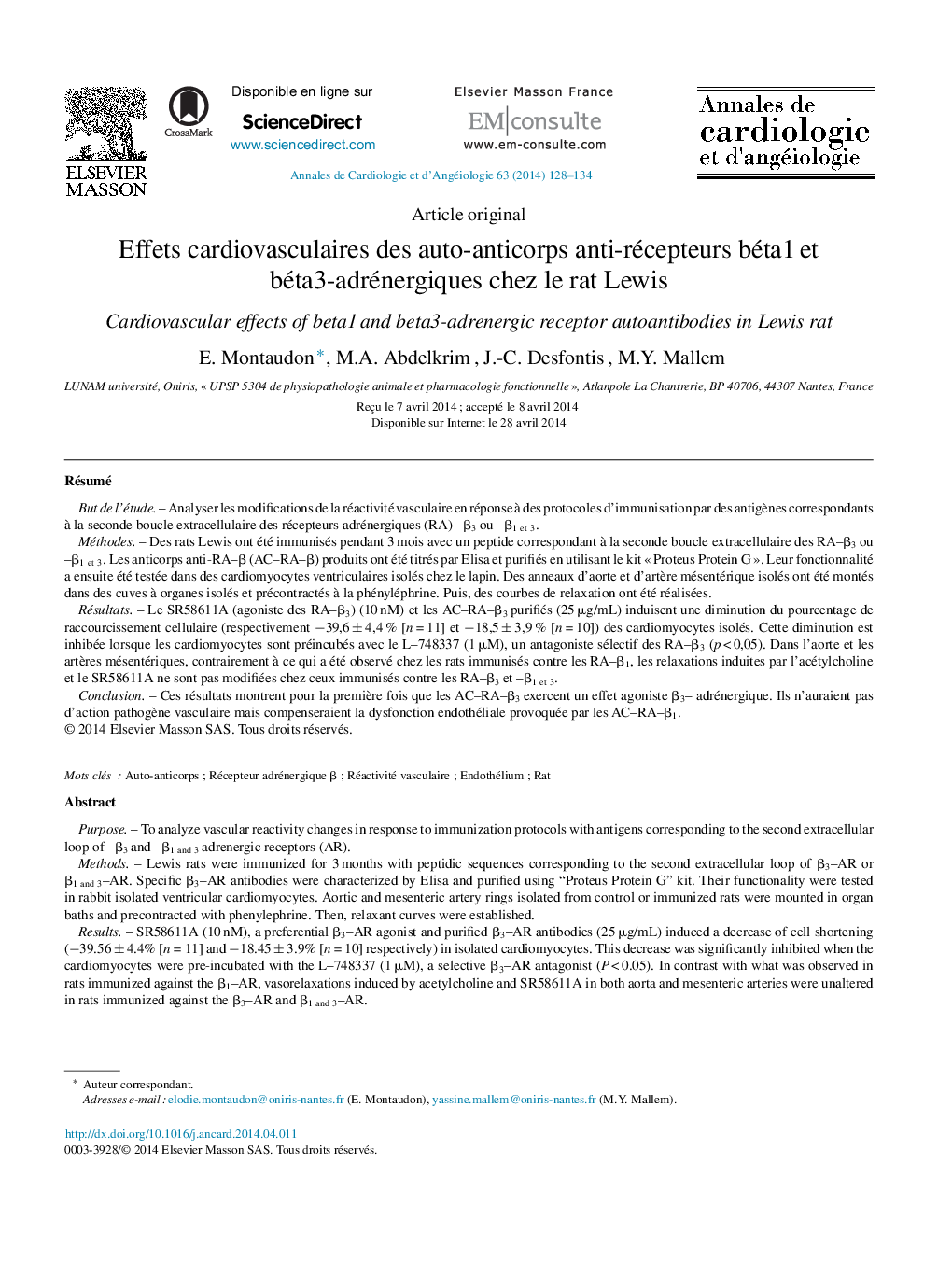| Article ID | Journal | Published Year | Pages | File Type |
|---|---|---|---|---|
| 2868809 | Annales de Cardiologie et d'Angéiologie | 2014 | 7 Pages |
RésuméBut de l’étudeAnalyser les modifications de la réactivité vasculaire en réponse à des protocoles d’immunisation par des antigènes correspondants à la seconde boucle extracellulaire des récepteurs adrénergiques (RA) –β3 ou –β1 et 3.MéthodesDes rats Lewis ont été immunisés pendant 3 mois avec un peptide correspondant à la seconde boucle extracellulaire des RA–β3 ou –β1 et 3. Les anticorps anti-RA–β (AC–RA–β) produits ont été titrés par Elisa et purifiés en utilisant le kit « Proteus Protein G ». Leur fonctionnalité a ensuite été testée dans des cardiomyocytes ventriculaires isolés chez le lapin. Des anneaux d’aorte et d’artère mésentérique isolés ont été montés dans des cuves à organes isolés et précontractés à la phényléphrine. Puis, des courbes de relaxation ont été réalisées.RésultatsLe SR58611A (agoniste des RA–β3) (10 nM) et les AC–RA–β3 purifiés (25 μg/mL) induisent une diminution du pourcentage de raccourcissement cellulaire (respectivement −39,6 ± 4,4 % [n = 11] et −18,5 ± 3,9 % [n = 10]) des cardiomyocytes isolés. Cette diminution est inhibée lorsque les cardiomyocytes sont préincubés avec le L–748337 (1 μM), un antagoniste sélectif des RA–β3 (p < 0,05). Dans l’aorte et les artères mésentériques, contrairement à ce qui a été observé chez les rats immunisés contre les RA–β1, les relaxations induites par l’acétylcholine et le SR58611A ne sont pas modifiées chez ceux immunisés contre les RA–β3 et –β1 et 3.ConclusionCes résultats montrent pour la première fois que les AC–RA–β3 exercent un effet agoniste β3– adrénergique. Ils n’auraient pas d’action pathogène vasculaire mais compenseraient la dysfonction endothéliale provoquée par les AC–RA–β1.
PurposeTo analyze vascular reactivity changes in response to immunization protocols with antigens corresponding to the second extracellular loop of –β3 and –β1 and 3 adrenergic receptors (AR).MethodsLewis rats were immunized for 3 months with peptidic sequences corresponding to the second extracellular loop of β3–AR or β1 and 3–AR. Specific β3–AR antibodies were characterized by Elisa and purified using “Proteus Protein G” kit. Their functionality were tested in rabbit isolated ventricular cardiomyocytes. Aortic and mesenteric artery rings isolated from control or immunized rats were mounted in organ baths and precontracted with phenylephrine. Then, relaxant curves were established.ResultsSR58611A (10 nM), a preferential β3–AR agonist and purified β3–AR antibodies (25 μg/mL) induced a decrease of cell shortening (−39.56 ± 4.4% [n = 11] and −18.45 ± 3.9% [n = 10] respectively) in isolated cardiomyocytes. This decrease was significantly inhibited when the cardiomyocytes were pre-incubated with the L–748337 (1 μM), a selective β3–AR antagonist (P < 0.05). In contrast with what was observed in rats immunized against the β1–AR, vasorelaxations induced by acetylcholine and SR58611A in both aorta and mesenteric arteries were unaltered in rats immunized against the β3–AR and β1 and 3–AR.ConclusionThese results show, for the first time, that β3–AR antibodies induced a β3–AR agonist-like activity. They would not have a vascular pathogenic action but would offset the endothelial dysfunction caused by β1–AR antibodies.
